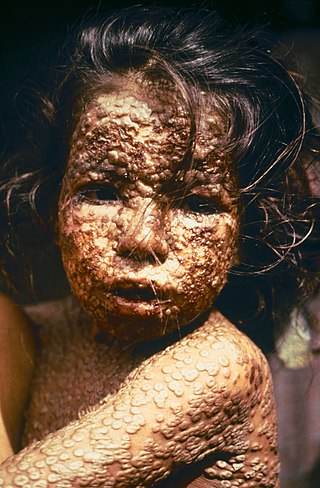
Cowpox is an infectious disease caused by the cowpox virus (CPXV). It presents with large blisters in the skin, a fever and swollen glands, historically typically following contact with an infected cow, though in the last several decades more often from infected cats. The hands and face are most frequently affected and the spots are generally very painful.

Vaccinia virus is a large, complex, enveloped virus belonging to the poxvirus family. It has a linear, double-stranded DNA genome approximately 190 kbp in length, which encodes approximately 250 genes. The dimensions of the virion are roughly 360 × 270 × 250 nm, with a mass of approximately 5–10 fg. The vaccinia virus is the source of the modern smallpox vaccine, which the World Health Organization (WHO) used to eradicate smallpox in a global vaccination campaign in 1958–1977. Although smallpox no longer exists in the wild, vaccinia virus is still studied widely by scientists as a tool for gene therapy and genetic engineering.

Parapoxvirus is a genus of viruses, in the family Poxviridae, in the subfamily Chordopoxvirinae. Like all members of the family Poxviridae, they are oval, relatively large, double-stranded DNA viruses. Parapoxviruses have a unique spiral coat that distinguishes them from other poxviruses. Parapoxviruses infect vertebrates, including a wide selection of mammals, and humans.
Orthopoxvirus is a genus of viruses in the family Poxviridae and subfamily Chordopoxvirinae. Vertebrates, including mammals and humans, and arthropods serve as natural hosts. There are 12 species in this genus. Diseases associated with this genus include smallpox, cowpox, horsepox, camelpox, and monkeypox. The most widely known member of the genus is Variola virus, which causes smallpox. It was eradicated globally by 1977, through the use of Vaccinia virus as a vaccine. The most recently described species is the Alaskapox virus, first isolated in 2015.

Camelpox is a disease of camels caused by the camelpox virus (CMPV) of the family Poxviridae, subfamily Chordopoxvirinae, and the genus Orthopoxvirus. It causes skin lesions and a generalized infection. Approximately 25% of young camels that become infected will die from the disease, while infection in older camels is generally more mild. Although rare, the infection may spread to the hands of those that work closely with camels.

Molluscum contagiosum virus (MCV) is a species of DNA poxvirus that causes the human skin infection molluscum contagiosum. Molluscum contagiosum affects about 200,000 people a year, about 1% of all diagnosed skin diseases. Diagnosis is based on the size and shape of the skin lesions and can be confirmed with a biopsy, as the virus cannot be routinely cultured. Molluscum contagiosum virus is the only species in the genus Molluscipoxvirus. MCV is a member of the subfamily Chordopoxvirinae of family Poxviridae. Other commonly known viruses that reside in the subfamily Chordopoxvirinae are variola virus and monkeypox virus.
Avipoxvirus is a genus of viruses within the family Poxviridae. Poxviridae is the family of viruses which cause the afflicted organism to have poxes as a symptom. Poxviruses have generally large genomes, and other such examples include smallpox and monkeypox. Members of the genus Avipoxvirus infect specifically birds. Avipoxviruses are unable to complete their replication cycle in non-avian species. Although it is comparably slow-spreading, Avipoxvirus is known to cause symptoms like pustules full of pus lining the skin and diphtheria-like symptoms. These diphtheria-like symptoms might include diphtheric necrotic membranes lining the mouth and the upper respiratory tract. Like other avian viruses, it can be transmitted through vectors mechanically such as through mosquitoes. There is no evidence that this virus can infect humans.
Turkeypox virus is a virus of the family Poxviridae and the genus Avipoxvirus that causes turkeypox. It is one of the most common diseases in the wild turkey population. Turkeypox, like all avipoxviruses, is transmitted either through skin contact or by arthropods acting as mechanical vectors.

A viral disease occurs when an organism's body is invaded by pathogenic viruses, and infectious virus particles (virions) attach to and enter susceptible cells.

Smallpox was an infectious disease caused by variola virus which belongs to the genus Orthopoxvirus. The last naturally occurring case was diagnosed in October 1977, and the World Health Organization (WHO) certified the global eradication of the disease in 1980, making smallpox the only human disease to be eradicated.
Yatapoxvirus is a genus of viruses, in the family Poxviridae, in the subfamily Chordopoxvirinae. Monkeys and baboons serve as natural hosts. There are two species in this genus. Diseases associated with this genus include: histiocytomas, tumor-like mass of mononuclear cells.
Chordopoxvirinae is a subfamily of viruses in the family Poxviridae. Vertebrates and arthropods serve as natural hosts. Currently, 52 species are placed in this subfamily, divided among 18 genera. Diseases associated with this subfamily include smallpox.
Capripoxvirus is a genus of viruses in the subfamily Chordopoxvirinae and the family Poxviridae. Capripoxviruses are among the most serious of all animal poxviruses. All CaPV are notifiable diseases to the OIE. Sheep, goat, and cattle serve as natural hosts. These viruses cause negative economic consequences by damaging hides and wool and forcing the establishment of trade restrictions in response to an outbreak. The genus consists of three species: sheeppox virus (SPPV), goatpox virus (GTPV), and lumpy skin disease virus (LSDV). They share no serological relationship with camel pox, horse pox, or avian poxes. Capripoxviruses for sheeppox and goatpox infect only sheep and goat respectively. However, it is probable that North American relatives, the mountain goat and mountain sheep, may be susceptible to the strains but has not been experimentally proven. Lumpy skin disease virus affects primarily cattle, but studies have been shown that giraffes and impala are also susceptible to LSDV. Humans cannot be infected by Capripoxviruses.

The monkeypox virus, is a species of double-stranded DNA virus that causes mpox disease in humans and other mammals. The monkeypox virus is a zoonotic virus belonging to the orthopoxvirus genus, making it closely related to the variola, cowpox, and vaccinia viruses. MPV is oval-shaped with a lipoprotein outer membrane. The genome is approximately 190 kb.
Orthopoxvirus inclusion bodies are aggregates of stainable protein produced by poxvirus virions in the cell nuclei and/or cytoplasm of epithelial cells in humans. They are important as sites of viral replication.
Leporipoxvirus is a genus of viruses, in the family Poxviridae, in the subfamily Chordopoxvirinae. Lagomorphs and squirrels serve as natural hosts. There are four species in this genus. Diseases associated with this genus include: myxomatosis.
Suipoxvirus is a genus of viruses in the family Poxviridae and subfamily Chordopoxvirinae. Swine serve as natural hosts. There is only one species in this genus: Swinepox virus. Diseases associated with this genus include asymptomatic skin disease.
Crocodylidpoxvirus is a genus of viruses, in the family Poxviridae, in the subfamily Chordopoxvirinae. Crocodiles serve as natural hosts. There is only one species in this genus: Nile crocodilepox virus. Diseases associated with this genus include: nodular skin lesions in young animals. Symptoms vary from a nonfatal dermatitis to more severe disease characterized by ophthalmia, rhinitis resulting in asphyxia, and debilitating illness with stunting and high mortality.
Raccoonpox virus (RCN) is a double-stranded DNA virus and a member of the orthopoxviruses in the family Poxviridae and subfamily Chordopoxvirinae which consists of eight genera: Avipoxvirus, Capripoxvirus, Leporipoxvirus, Molluscipoxvirus, Orthopoxvirus, Parapoxvirus, Suipoxvirus and Yatapoxvirus Vertebrates are the natural host of Chordopoxvirinae subfamily viruses. More specifically, raccoons are the natural hosts of RCN. RCN was isolated in 1961 from the upper respiratory tissues of 2 raccoons in a group of 92 observably healthy raccoons trapped close to Aberdeen, Maryland.

Red deerpox virus (RDPV) is a species of virus in the genus Parapoxvirus. It has been reported in deer in New Zealand, and in wild ruminants in Italy.














